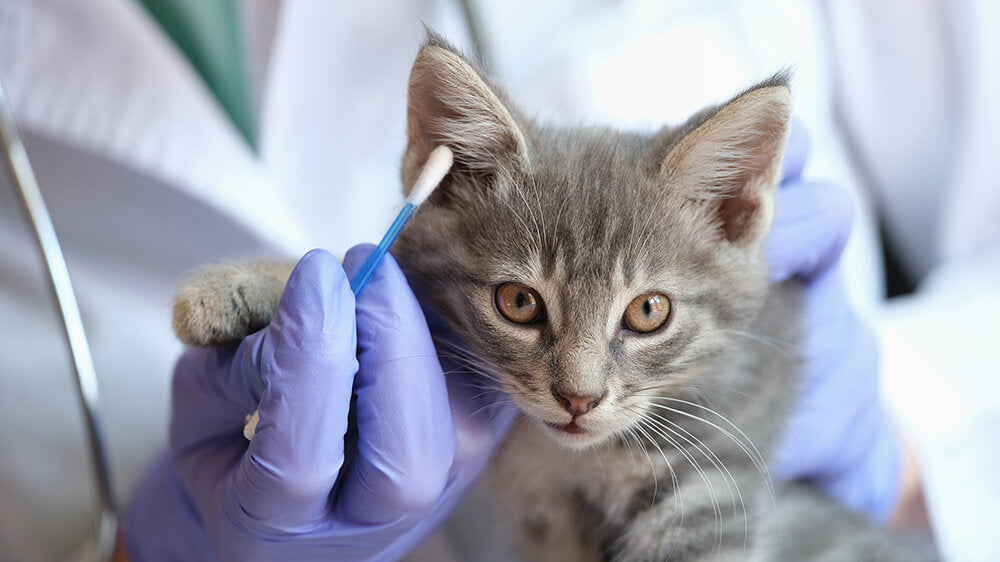
- by Dr.Thilo Senst
Detecting and Treating Fungal Ear Infections in Cats: Essential Guide
- by Dr.Thilo Senst
How to Detect and Treat Fungal Ear Infections in Cats
A cat’s ears are sensitive and prone to a range of infections, including fungal ear infections, which can be particularly uncomfortable for our feline friends. Left untreated, these infections can lead to more severe health complications, making it essential for pet owners to detect and treat them promptly. This article explores how to identify a cat ear infection, the causes, and effective treatment options for keeping your pet’s ears healthy.
Fungal ear infections in cats often present specific symptoms that, when identified early, can lead to prompt treatment. Here are common signs that your cat may be suffering from a fungal ear infection:
Recognising these signs is the first step towards treating a cat ear infection and restoring your pet’s comfort and ear health.
Understanding the causes of fungal ear infections can help prevent their occurrence. Here are some of the primary reasons:
Fungal ear infections in cats are typically caused by yeast, particularly a species called Malassezia. This yeast occurs naturally on the skin but can multiply rapidly under favourable conditions, causing an infection. Cats with floppy ears or those that are prone to allergies are especially at risk, as their ear structures can trap moisture, creating an ideal environment for yeast growth.
According to recent statistics from UK pet health studies, around 20% of cats develop some form of ear infection during their lifetime, with fungal infections making up a significant proportion. Keeping cats indoors during humid weather and maintaining regular ear hygiene have been shown to reduce the risk of these infections by up to 30%.
Imagine a greenhouse that thrives in a warm, moist environment. Just as a greenhouse requires ventilation to prevent mould growth, a cat’s ears need to stay clean and dry to prevent infections. Excessive moisture and lack of airflow create a breeding ground for fungi, similar to what happens in a poorly ventilated greenhouse.
Proper treatment is essential for eradicating a fungal ear infection and restoring your cat’s health. Here’s a step-by-step guide:
While some mild infections can be managed at home, it’s best to get a vet’s diagnosis for a cat ear infection. Your vet can examine the ear and confirm the presence of a fungal infection through tests.
Antifungal ear drops are an effective treatment for cat ear infections. Dr. Senst Antiseptic Cat Ear Drops for Infections provide targeted relief and are designed to combat common fungal pathogens. Always follow the dosage instructions on the product or those provided by your vet.
Use a gentle cat ear cleaner to remove excess wax and discharge, which can aid in the treatment process. Avoid using cotton swabs inside the ear canal, as this can push debris further in. Instead, use a damp cloth or cotton ball to clean the outer ear.
Cats may become stressed during treatment, so using a calming product, such as Dr. Senst Cat Calming Hemp Oil for Cats, can help soothe them.
Check for improvement in your cat’s symptoms over the next few days. If the infection persists or worsens, consult your vet for further guidance.
Preventative care can significantly reduce the likelihood of a fungal ear infection in cats. Here are some tips:
No, human ear drops are not suitable for cats. Instead, use veterinary-recommended products like Dr. Senst Antiseptic Cat Ear Drops for Infections.
Fungal infections aren’t usually contagious, but if multiple pets have similar symptoms, it’s best to have them checked as they may have been exposed to the same environmental factors.
With consistent treatment, most fungal ear infections in cats improve within 1-2 weeks. However, more severe cases may require longer treatment.
Proper ear care is essential for preventing fungal infections and ensuring a comfortable, healthy life for your feline companion. Here are some Dr. Senst products to help with both treatment and prevention:
By following these steps and using quality products, you can effectively manage and prevent fungal ear infections in your cat, keeping their ears healthy and itch-free.
![]()
Enter your details & download our comprehensive 50+ page printable Dr. Senst Pet Care Planner completley FREE! - keep track of all your pet’s needs, from medical history and training to vet visits, grooming, diet, and more!










Share:
Dog Potty Training: Techniques for Success in Outdoor Relief
Cat Eye Injury Care: Essential First Aid Tips for Pet Owners